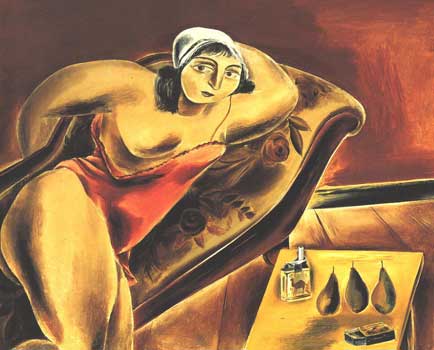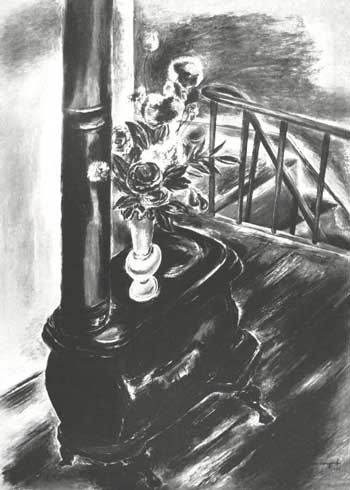1930年代の彼の作品は、婦人像、静物画、風景画の三つの主な題材に入ります。
彼の二度目のフランス訪問の後、彼の最も頻繁に使ったテーマは女性になりました。
男性像は、それ以来彼の絵の中でほとんど作画されることはありませんでした。
彼の官能的で、表情が無くそして暗くて濃いアイ・ラッシュの女の子は、いろいろの
段階の衣服を脱がせた状態で、喫煙しているか決して読んでいない新聞を持っています。
彼女達は何時もただひとりで、そして静寂で物思わしげな、何かを待っている雰囲気があり
ました。 彼女達の性的な磁気作用は、パスキンの作品を思わせる感傷と憂愁をしばしば
混ぜ合わせていました。
彼女達は、ほとんど強烈に個性的ではありません;クニヨシが興味を持っているそれは、
彼女達の性格と言うより彼女達の感性からの嘆願でした。
「私は、婦人を描くのが好きです。」 彼は言っていました、「しかし私は唯一人の女性を
描くことはしません、私は私の知っているそして感じる全ての女性を描きます。 これは
東洋的伝統だと思います、しかし私の描き方は西洋的伝統です。」

"Circus Girl Resting", 1931 Oil on Canvas (40 x 65 in) Fukutake Shoten Collection,
Yasuo Kuniyoshi Museum. Okayama, Japan
His work of the 1930's falls into three main classes of subjects - women, still-
life, landscape. After his second visit to France his most frequent theme became
women. Men have figured hardly at all in his art since then. His girls with their
voluptuous, expressionless faces and dark heavy-lashed eyes were shown sitting
in various stages of undress, smoking or holding newspapers which they were
never reading. They were always alone and they had an air of waiting, silence
and pensiveness. Their sexual magnetism was often combined with a languor and
weariness that remind one of Pascin. They were seldom strongly individualized;
it was their sensuous appeal he was interested in rather than their character.
"I like to paint women," he has said, "but I don't paint just one woman, I put in
what I know and sense about all women. I think this is in the Eastern tradition,
but the way I paint is in the Western tradition."

"Girl on Sofa", 1925. Oil on Canvas (30 x 36 in) Arizona State University Art Museum,
Tempe, Arizona.
彼の二度目のフランス訪問の後、彼の最も頻繁に使ったテーマは女性になりました。
男性像は、それ以来彼の絵の中でほとんど作画されることはありませんでした。
彼の官能的で、表情が無くそして暗くて濃いアイ・ラッシュの女の子は、いろいろの
段階の衣服を脱がせた状態で、喫煙しているか決して読んでいない新聞を持っています。
彼女達は何時もただひとりで、そして静寂で物思わしげな、何かを待っている雰囲気があり
ました。 彼女達の性的な磁気作用は、パスキンの作品を思わせる感傷と憂愁をしばしば
混ぜ合わせていました。
彼女達は、ほとんど強烈に個性的ではありません;クニヨシが興味を持っているそれは、
彼女達の性格と言うより彼女達の感性からの嘆願でした。
「私は、婦人を描くのが好きです。」 彼は言っていました、「しかし私は唯一人の女性を
描くことはしません、私は私の知っているそして感じる全ての女性を描きます。 これは
東洋的伝統だと思います、しかし私の描き方は西洋的伝統です。」

"Circus Girl Resting", 1931 Oil on Canvas (40 x 65 in) Fukutake Shoten Collection,
Yasuo Kuniyoshi Museum. Okayama, Japan
His work of the 1930's falls into three main classes of subjects - women, still-
life, landscape. After his second visit to France his most frequent theme became
women. Men have figured hardly at all in his art since then. His girls with their
voluptuous, expressionless faces and dark heavy-lashed eyes were shown sitting
in various stages of undress, smoking or holding newspapers which they were
never reading. They were always alone and they had an air of waiting, silence
and pensiveness. Their sexual magnetism was often combined with a languor and
weariness that remind one of Pascin. They were seldom strongly individualized;
it was their sensuous appeal he was interested in rather than their character.
"I like to paint women," he has said, "but I don't paint just one woman, I put in
what I know and sense about all women. I think this is in the Eastern tradition,
but the way I paint is in the Western tradition."

"Girl on Sofa", 1925. Oil on Canvas (30 x 36 in) Arizona State University Art Museum,
Tempe, Arizona.



















